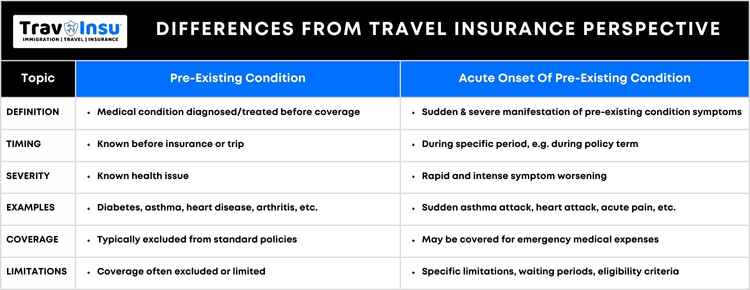What Is Acute Onset Of Pre-Existing Conditions

Acute onset of pre-existing conditions coverage is a term commonly used in insurance, particularly in the context of travel insurance or medical insurance for international travelers.
An acute onset of a pre-existing condition is a sudden and unexpected outbreak or recurrence of a prior condition that occurs spontaneously and without any advance warning.
Here’s a breakdown of what it means:
- Acute onset: Refers to the sudden and unexpected occurrence of symptoms related to a pre-existing condition. It implies that the condition worsened suddenly and required immediate medical attention.
- Pre-existing conditions: A person has These medical conditions before obtaining insurance coverage. Examples include diabetes, asthma, heart conditions, etc.
- Coverage: Insurance policies typically outline what they cover and do not cover. Acute onset of pre-existing conditions coverage means that the insurance policy will cover medical expenses incurred due to the sudden worsening of a pre-existing condition during the period of coverage.
It’s Important To Note A Few Key Points:
- Coverage Limitations: There are often limitations on the amount of coverage provided and the specific circumstances under which coverage applies. These limitations can vary depending on the insurance provider and specific insurance policy.
- Waiting Periods: Some insurance policies may have a waiting period before coverage for pre-existing conditions kicks in. During this waiting period, expenses related to pre-existing conditions may not be covered.
- Documentation Requirements: Insurance companies may require documentation to prove that the sudden onset of symptoms is related to a pre-existing condition. This could include medical records, doctor’s statements, etc.
It’s essential for individuals considering travel or medical insurance to carefully review the terms and conditions of the policy, especially regarding coverage for pre-existing conditions, to ensure they understand what is and isn’t covered.
Acute Onset Of Pre-Existing Conditions Definition
The definition of “acute onset of pre-existing conditions” can vary depending on the context, such as in the insurance industry or medical field. However, in general terms:
Acute Onset:
“Acute” refers to a sudden and severe onset of symptoms or a condition. It implies that the symptoms appear rapidly and often require immediate attention or treatment. For example, acute illnesses like a sudden asthma attack or a heart attack have sudden and severe symptoms.
Pre-Existing Conditions:
Medical conditions or other health problems that an individual has been diagnosed with or received treatment for (any ongoing illness, sickness, disease, injury, or other medical, mental, or nervous condition) that existed with reasonable medical certainty before obtaining insurance coverage or seeking medical attention for a specific event or period is considered pre-existing conditions.
When combined, “acute onset of pre-existing conditions” typically refers to a situation where a pre-existing medical condition suddenly worsens or manifests with acute symptoms during a defined period, such as while traveling or during the term of the insurance policy.
This coverage provision may allow individuals with pre-existing conditions to receive coverage for medical expenses related to the sudden worsening of their condition, even if the condition was known before obtaining insurance or seeking medical treatment.

What Does Acute Onset Of Pre-Existing Conditions Mean For Travel Insurance?
In the context of travel insurance, “acute onset of pre-existing conditions” typically refers to a specific type of coverage provided by some travel insurance policies. It is a sudden and unexpected outbreak or recurrence of a prior condition that occurs spontaneously either in the form of physician recommendations or symptoms. Treatment must be obtained within 24 hours of the sudden and unexpected outbreak or recurrence.
The acute onset must occur after the effective date of the policy. Here’s what it generally means:
Coverage For Pre-Existing Conditions:
Many travel insurance plans exclude coverage for pre-existing medical conditions. However, the only exception is some travel insurance plans offer coverage for acute onset of pre-existing conditions.
Definition Of Acute Onset:
The term “acute onset” typically implies that the pre-existing condition suddenly and unexpectedly becomes severe or worsens during the trip, is of short duration, is rapidly progressive, and requires immediate medical attention. It’s important to note that the definition of “acute onset” can vary between insurance providers and policies, so it’s crucial to read the policy documents carefully.
Coverage Scope:
When a policy includes coverage for the acute onset of pre-existing conditions, it usually covers emergency medical expenses incurred as a result of the sudden worsening of a pre-existing condition during the trip. This coverage may include expenses such as hospitalization, doctor visits, and emergency medical evacuation.
Limits And Conditions:
Travel insurance policies that offer coverage for the acute onset of pre-existing conditions often have limits and conditions associated with this coverage. These may include waiting periods, maximum coverage amounts, and requirements for medical documentation.
Exclusions:
Not all pre-existing conditions may be covered under this type of coverage, and certain exclusions may apply. For example, conditions that are considered stable or controlled before the trip may not be covered.
Policy Specifics:
Travelers need to review the specific terms and conditions of their travel insurance policy to understand what is covered under the acute onset of pre-existing conditions provision. This includes understanding any limitations, exclusions, and requirements for eligibility.
Choosing a visitor insurance policy can be difficult especially if you are with a traveling companion as it is harder to guess if the traveling companion has a pre-existing condition. for travelers with pre-existing medical conditions, having coverage for the acute onset of those conditions can provide valuable peace of mind while traveling.
However, it’s crucial to choose a visitor medical insurance plan that suits your needs and to thoroughly understand the coverage provided. Recommend checking eligible medical expenses and exclusions on the plan’s description of coverage. Always compare and buy visitors insurance. It’s a good idea to inquire with a licensed insurance agent when considering a policy.

Best Travel Insurance Plans For Acute Onset Of Pre-Existing Conditions
Some US insurance providers that offer travel medical insurance for seniors over 70 include:
- Trawick International
- International Medical Group (IMG)
- WorldTrips
- Seven Corners
Comprehensive Coverage Plans:
- Patriot America Plus
- Atlas America
- Atlas International Premium
- Safe Travels USA Comprehensive
- Patriot Platinum
- Patriot Platinum International
- Safe Travels USA
- Seven Corners Travel Medical Basic – USA
Limited Coverage Plans:
Compare Travel Insurance Plans
You can also find some other best travel medical insurance for visitors to the USA available for you or your parents visiting the USA.
What Can Be Considered Acute Onset?
“Acute onset” generally refers to the sudden and severe onset of symptoms or a medical condition. It implies a rapid and often intense manifestation of symptoms that may require immediate attention or treatment. Here are some examples of situations that can be considered as an acute onset:
- Sudden and Severe Pain: This could include sudden and severe abdominal pain, chest pain, or headaches.
- Acute Respiratory Symptoms: Rapid onset of symptoms such as shortness of breath, wheezing, or severe coughing.
- Neurological Symptoms: Sudden onset of neurological symptoms such as weakness or numbness in limbs, sudden loss of consciousness, or seizures.
- Cardiovascular Events: Acute events such as a heart attack (myocardial infarction) or stroke.
- Allergic Reactions: Acute onset of severe allergic reactions (anaphylaxis) to triggers such as foods, insect stings, or medications.
- Infectious Diseases: Rapid onset of symptoms associated with infections, such as high fever, severe fatigue, vomiting, or diarrhea.
- Mental Health Emergencies: Acute onset of severe mental health symptoms, such as acute psychosis, severe depression, or suicidal ideation.
- Traumatic Injuries: Sudden and severe injuries resulting from accidents or trauma, such as fractures, lacerations, or head injuries.
In summary, any medical condition or symptom that develops suddenly and severely, requiring immediate attention or intervention, can be considered an acute onset. It’s important to seek prompt medical care in such situations to address the underlying cause and prevent further complications.
Acute Onset Of Pre-Existing Conditions Examples
Examples of the acute onset of pre-existing conditions can vary widely depending on the individual’s medical history and the specific conditions covered by the insurance policy. Here are some hypothetical examples to illustrate:
Asthma:
An individual with a history of asthma experiences a sudden and severe asthma attack while hiking in a mountainous region. They develop acute shortness of breath and wheezing, requiring immediate medical attention and treatment.
Heart Condition:
A traveler with a pre-existing heart condition experiences acute chest pain and difficulty breathing while on a cruise ship. The symptoms indicate a possible heart attack, necessitating emergency medical care and possible evacuation to a hospital on land for further treatment.
High Blood Pressure:
A person has high blood pressure and/or diabetes and all of a sudden gets a heart attack while on tour.
Diabetes:
A person with diabetes gets a diabetic shock and experiences a sudden and severe drop in blood sugar levels while exploring a foreign city. They become disoriented and unresponsive, requiring emergency medical intervention, including administration of glucose and monitoring of vital signs.
Mental Health Condition:
A traveler with a history of anxiety disorder experiences a sudden and severe panic attack while flying on an airplane. They become agitated and hyperventilate, requiring assistance from the flight crew and possible medical evaluation upon landing.
Digestive Issues:
An individual with a history of gastrointestinal problems experiences acute abdominal pain and vomiting after consuming contaminated food while on a culinary tour abroad. They require medical treatment for food poisoning and dehydration.
Joint Pain (Arthritis):
A traveler with arthritis experiences sudden and severe joint pain and swelling while participating in a guided hiking excursion. The pain becomes debilitating, necessitating assistance and possibly medical evaluation for pain management.
These examples illustrate how the acute onset of pre-existing conditions can manifest in various medical emergencies during travel. In each case, the sudden and severe worsening of symptoms requires immediate medical attention, highlighting the importance of having coverage for such situations under a travel insurance policy.
NOTE: These are just examples and it will be up to the attending physician’s medical report and the insurance company and its claim department, during the claims process, to determine whether a condition can be deemed an actual acute onset or not. The final determination may vary regardless of your situation.

The Difference Between Pre-Existing And Acute Onset Of Pre-Existing Conditions
The primary difference between a pre-existing condition and the acute onset of a pre-existing condition lies in the timing and severity of the symptoms:
Pre-Existing Condition:
- A pre-existing condition refers to a medical condition that an individual has been diagnosed with or received treatment for before obtaining insurance coverage or seeking medical attention for a specific event or period.
- These conditions are known health issues that existed before the insurance policy took effect or before the individual embarked on a trip.
- Examples of pre-existing conditions include diabetes, asthma, heart disease, arthritis, etc.
- Standard insurance policies often exclude coverage for pre-existing conditions, meaning expenses related to these conditions may not be covered unless specified otherwise in the policy.
- Examples of Pre-existing coverage plans:
Compare Travel Insurance Plans
Acute Onset Of Pre-Existing Condition:
- Acute onset of a pre-existing condition refers to the sudden and severe manifestation of symptoms related to a pre-existing condition during a specific period, such as while traveling or during the term of an insurance policy.
- It implies a rapid and often intense worsening of symptoms that may require immediate medical attention or intervention.
- Insurance policies that offer coverage for the acute onset of pre-existing conditions typically provide coverage for emergency medical expenses incurred as a result of the sudden worsening of a pre-existing condition during the covered period.
- The coverage for the acute onset of pre-existing conditions may have specific limitations, waiting periods, and eligibility criteria outlined in the insurance policy.
In summary, while a pre-existing condition is a known health issue that existed before obtaining insurance coverage, the acute onset of a pre-existing condition refers to the sudden and severe worsening of symptoms related to that condition during a defined period, such as a trip covered by travel insurance. The distinction is important in determining coverage and eligibility for insurance benefits.
What Is The Difference Between Acute Onset Of Pre-Existing Conditions And Sudden And Unexpected Recurrence Of Pre-Existing Conditions?
The terms “acute onset of pre-existing conditions” and “sudden and unexpected recurrence of pre-existing conditions” are often used interchangeably, but they can have subtle differences in interpretation depending on the context. Here’s a breakdown of each:
Acute Onset Of Pre-Existing Conditions:
- This term typically refers to the sudden and severe manifestation of symptoms related to a pre-existing condition during a specific period, such as while traveling or during the term of an insurance policy.
- It implies a rapid and often intense worsening of symptoms that may require immediate medical attention or intervention.
- Insurance policies that offer coverage for the acute onset of pre-existing conditions generally provide coverage for emergency medical expenses incurred as a result of the sudden worsening of a pre-existing condition during the covered period.
Sudden And Unexpected Recurrence Of Pre-Existing Conditions:
- This term also describes the sudden reappearance or exacerbation of symptoms related to a pre-existing condition.
- The key difference may lie in the wording, with “recurrence” suggesting a return or reappearance of symptoms that were previously experienced, whereas “acute onset” may focus more on the sudden and severe nature of the symptoms rather than their recurrence.
- Insurance policies may use either term to describe coverage for unexpected medical events related to pre-existing conditions, and the specific wording may vary among policies and providers.
In summary, while both terms describe the sudden worsening of symptoms related to pre-existing conditions, “acute onset” emphasizes the sudden and severe nature of the symptoms during a specific period, while “sudden and unexpected recurrence” may highlight the unexpected reappearance or exacerbation of symptoms that were previously experienced. However, the distinction between the two terms may vary depending on the context in which they are used.
What Isn’t Covered By Acute Onset Of Pre-Existing Conditions Coverage?
While coverage for the acute onset of pre-existing conditions can provide valuable protection for travelers with existing health conditions, there are typically limitations and exclusions associated with this coverage.
In the context of travel insurance, health conditions that are diagnosed as chronic or congenital are typically excluded from travel medical insurance policies.
Any ongoing medical condition for which medications are regularly taken at the time of purchase is not considered acute onset of a pre-existing condition. Here are some common exclusions that may apply:
Pre-Existing Conditions Stability:
Acute onset coverage may not apply if the pre-existing condition was not stable before the trip. Stability requirements vary among insurance policies but often involve a specified period during which the condition has remained unchanged or has been under control. If the condition does not meet the stability requirement, expenses related to its acute onset may not be covered.
Excluded Conditions:
Certain pre-existing conditions may be excluded from coverage altogether. Insurers may have a list of specific conditions that are not covered under the acute onset provision. Common exclusions may include chronic conditions that are not expected to have sudden acute episodes, such as ongoing treatments for cancer or kidney dialysis.
Treatment Delay:
Coverage for the acute onset of pre-existing conditions typically applies only to expenses incurred for the immediate treatment of the acute episode during the trip. Expenses related to ongoing or follow-up treatment after returning home may not be covered.
Waiting Periods:
Some insurance policies impose waiting periods before coverage for pre-existing conditions becomes effective. During this waiting period, expenses related to the acute onset of pre-existing conditions may not be covered. Waiting periods vary among policies and can range from a few days to several months.
Coverage Limits:
There may be limits on the amount of coverage provided for the acute onset of pre-existing conditions. This could include limits on the total amount payable per incident, as well as limits on specific types of medical expenses, such as hospitalization, emergency room visits, or medical evacuation.
Non-Emergency Treatment:
Acute onset coverage is typically designed to cover expenses for emergency medical treatment necessitated by the sudden worsening of a pre-existing condition. Non-emergency or routine medical care may not be covered under this provision.
Failure To Follow Treatment Plan:
If the insured individual fails to follow the prescribed treatment plan for their pre-existing condition, coverage for the acute onset of that condition may be voided. Insurers may require proof of compliance with treatment recommendations to validate claims.
It’s important for travelers to carefully review the terms and conditions of their travel insurance plan to understand the specific limitations and exclusions associated with coverage for the acute onset of pre-existing conditions.

Up To What Age Can I Get The Coverage For Acute Onset Of Pre-Existing Conditions?
The age limit for coverage of acute onset of pre-existing conditions can vary depending on the insurance provider and the specific policy terms.
- Some insurance companies may have age restrictions or limitations on coverage for pre-existing conditions, including acute onset coverage.
- In general, many travel insurance policies that offer coverage for pre-existing conditions, including acute onset, may have age limits for eligibility.
- These age limits can vary widely among insurers and policies.
- Some insurers may have age limits as low as 65 or 70 years old
- While others may offer coverage up to age 99.
It’s essential to carefully review the terms and conditions of the insurance policy to determine if there are any age restrictions or limitations on coverage for pre-existing conditions, including acute onset coverage.
NOTE: If you have specific concerns about age eligibility, it’s advisable to contact the insurance provider directly to inquire about their policy terms in the insurance plan and any available options.
What Is The Purpose Of Acute Onset Of Pre-Existing Conditions Coverage?
The purpose of acute onset of pre-existing conditions coverage is to provide protection and assistance to travelers who have pre-existing medical conditions in case they experience a sudden and severe exacerbation of their condition while traveling. Here are some key reasons why this coverage is important:
- Emergency Medical Care: Traveling with pre-existing medical conditions can pose risks, as unexpected health issues may arise during the trip. Acute onset coverage ensures that travelers have access to emergency medical care if their pre-existing condition suddenly worsens, potentially saving lives and preventing further complications.
- Peace of Mind: For individuals with pre-existing conditions, the fear of experiencing a medical emergency while traveling can be stressful. Acute onset coverage offers peace of mind, knowing that they have financial protection and assistance available if they need urgent medical treatment while away from home.
- Financial Protection: Medical emergencies abroad can be financially burdensome, especially if they are related to pre-existing conditions. Acute onset coverage helps mitigate the financial impact by covering emergency medical expenses, including hospitalization, doctor visits, medications, and even medical evacuation if necessary.
- Enhanced Access to Care: Knowing that acute onset coverage is available may encourage individuals with pre-existing conditions to seek prompt medical attention if needed, rather than delaying or avoiding treatment due to concerns about cost or insurance coverage.
- Improved Travel Experience: With acute onset coverage in place, travelers with pre-existing conditions can feel more confident and comfortable exploring new destinations and participating in activities during their trip, knowing that they are prepared for potential medical emergencies.
Overall, the purpose of acute onset of pre-existing conditions coverage is to ensure that travelers with pre-existing medical conditions can enjoy their travel experiences with greater peace of mind, knowing that they have access to emergency medical care and financial protection if needed.
Why Doesn’t Travel Medical Insurance Typically Cover Pre-Existing Conditions?
Travel medical insurance provides coverage if you have a medical emergency while traveling outside your home country. Travel medical insurance typically doesn’t cover pre-existing conditions for several reasons:
Risk Assessment:
Insurance companies assess the risk associated with providing coverage to individuals with pre-existing conditions. Since pre-existing conditions are known health issues, they represent a high risk for insurers because there’s a likelihood that the insured individual may require medical treatment related to those conditions while traveling.
Cost Considerations:
Providing coverage for pre-existing conditions can significantly increase the cost of travel medical insurance. Insurers would need to account for the potentially higher frequency of claims and the increased medical expenses associated with managing pre-existing conditions while traveling.
Adverse Selection:
If insurers were to offer comprehensive coverage for pre-existing conditions without proper risk assessment or additional premiums, it could lead to adverse selection. This means that individuals with pre-existing conditions would be more likely to purchase insurance, leading to an imbalanced risk pool and potentially unsustainable costs for the insurer.
Policy Limitations:
Many travel insurance policies are designed to cover unforeseen events or emergencies that occur during the trip. Pre-existing conditions are, by definition, existing health conditions that were known before the trip. Therefore, they may fall outside the scope of coverage provided by standard travel medical insurance policies.
Specialized Coverage Options:
While standard travel medical insurance may not cover pre-existing conditions, some insurers offer specialized policies or optional add-ons that provide coverage for specific pre-existing conditions or offer coverage for acute onset of pre-existing conditions during the trip. These specialized policies often come with higher premiums or specific eligibility criteria.
Overall, the exclusion of pre-existing conditions from standard travel medical insurance is primarily driven by the need for insurers to manage risks and costs effectively while providing coverage for unforeseen events during travel.
Individuals with pre-existing conditions may need to explore alternative insurance options or consider purchasing specialized coverage tailored to their needs.
There are a select few travel insurance plans that offer coverage for pre-existing conditions.
Conclusion
Understanding the concept of acute onset of pre-existing conditions is essential for travelers seeking comprehensive insurance coverage. This provision ensures that individuals with known health conditions have access to emergency medical care and financial protection in the event of sudden exacerbation of their pre-existing condition while away from home.
By offering coverage for the sudden and severe manifestation of symptoms during a specific period, such as while traveling, insurance policies that include acute onset coverage provide peace of mind and assurance to travelers facing medical uncertainties.
However, it’s crucial for travelers to carefully review the terms and conditions of their insurance policies to understand the scope of coverage, any limitations, and eligibility criteria associated with the acute onset of pre-existing conditions.
With proper understanding and preparation, travelers can embark on their journeys with confidence, knowing that they are adequately protected against unforeseen medical emergencies related to pre-existing conditions.










